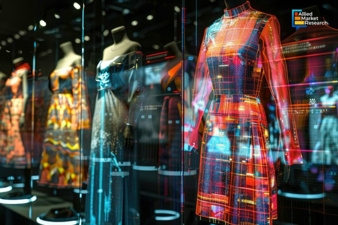22.10.24 – AI-powered digital textile printing
How has integration of AI Tools revolutionized the industry?
Digital textile printing is a type of fabric designing that involves using inkjet printers and equipment to print different patterns, textures, and motifs on a piece of textile or garment. Compared to traditional printing methods, this new technology offers higher versatility and efficiency.
Garment companies are increasingly adopting digital fabric designing techniques to print unique textures on different materials including silk, cotton, nylon, leather, plastic, etc. Moreover, resource optimisation is one major consideration behind garment businesses shifting toward digital textile printing. Traditional printing technologies result in a lot of wastage and the processes involved are highly time-consuming. In comparison, modern digital techniques require minimal raw materials and setup time, thus enhancing the productivity of the company.
Capitalising on the opportunities offered by Artificial Intelligence
Recently, Allied Market Research published a report on the digital textile printing market, highlighting that the sector is anticipated to gather a sum of $7.9 billion by 2030. The sector accounted for $2.0 billion in 2020 and is projected to rise at 14.8% CAGR from 2021 to 2030. The emergence of advanced technologies such as AI has opened new avenues of growth in the industry. For example, almost all major companies operating in the field of digital fabric designing have started using AI tools to perform standardised, repetitive tasks of arranging graphics and textures onto the garment. AI-based tools and machine learning algorithms are primarily being used to analyse user preferences, study the trends in the industry, and recommend creative elements and patterns to manufacturers. Furthermore, designers are even employing AI-powered software applications such as Midjourney and Dall E to create unique and customised styles to satisfy customer demands. Thus, the integration of these advanced technologies has made it possible for garment companies to produce personalised goods on a mass level, thus aiding in expanding their foothold globally. Apart from automation and personalisation, quality control is another area where AI is gradually replacing traditional modes of working. Many leading textile manufacturers across the globe have started utilising AI-based cameras and sensors that study the quality of every piece of garment that is being manufactured before it reaches the customer. Along with this, machine learning algorithms are also used by many designers to detect flaws, imperfections, color deviations, and printing errors, thereby ensuring that every designed fabric matches the highest level of standards set by the company.
Atexco and Zimmer Austria lead the way in AI-powered digital textile printing technologies
In the past few years, many leading fabric-designing companies have launched inventive products, thereby creating new investment opportunities in the sector. In June 2023, Atexco, a leading inkjet printer manufacturer, unveiled its novel VEGA9180DI textile printer. Designed to provide the highest quality of colour purity and accuracy, the printer features intelligent print protection and a temperature control system that helps enhance colour expression and permeability. In October 2023, Zimmer Austria, a leading digital printing machine manufacturer, announced the launch of a new generation of Colaris printers. Installed with a vision camera system, the innovative printer generation with 16 colour groups helps in fitting a design or a pattern onto a fabric perfectly. The innovative product has played an important role in the transition toward automation in digital textile designing.
To sum it up, the digital textile printing industry is expected to witness huge growth in the coming period on account of the rising demand for customised and personalised apparel. In the past few years, many companies have started adopting AI-based tools to overcome the drawbacks associated with traditional printing which has helped the sector flourish.

